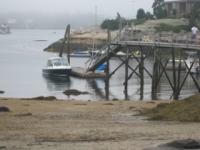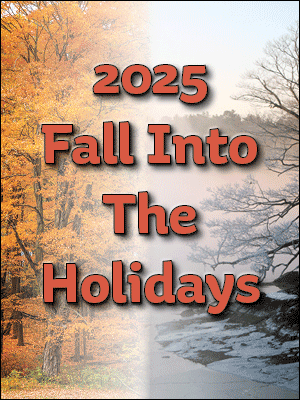An island apart
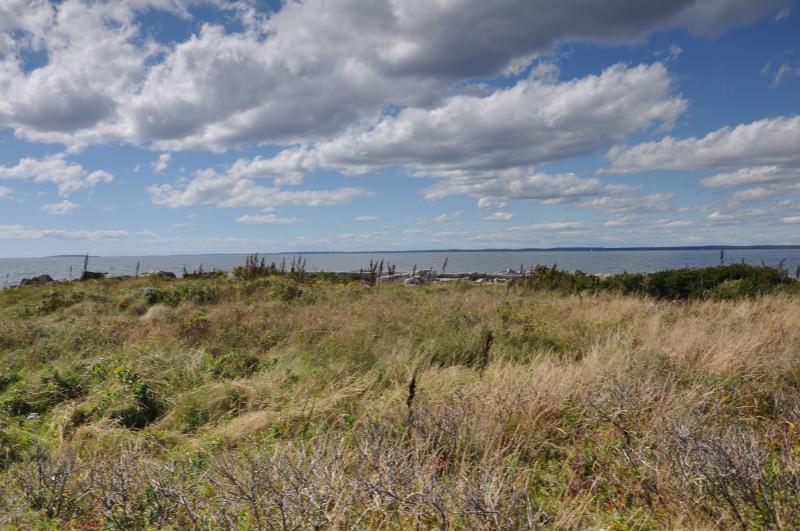 Damariscove, which is located five miles east from Boothbay Harbor, has been among other things, a place for Abenaki tribes to gather food, a place for drying fish, a Coast Guard station, a safe harbor and now a preserve for wildlife. BEN BULKELEY/Boothbay Register
Damariscove, which is located five miles east from Boothbay Harbor, has been among other things, a place for Abenaki tribes to gather food, a place for drying fish, a Coast Guard station, a safe harbor and now a preserve for wildlife. BEN BULKELEY/Boothbay Register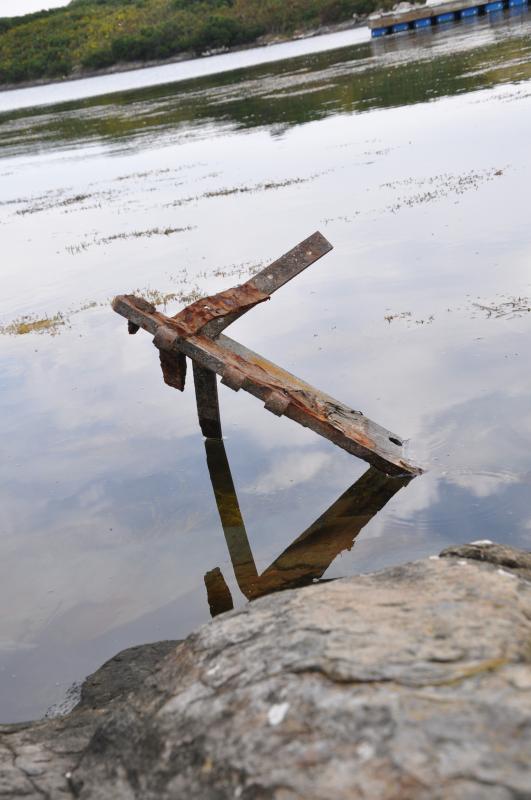 A rusted piece of metal is all that remains of a ship near where the drying racks were once located. BEN BULKELEY/Boothbay Register
A rusted piece of metal is all that remains of a ship near where the drying racks were once located. BEN BULKELEY/Boothbay Register A seagull watches as Balmy Days Cruises' Novelty came in to dock at Damariscove. BEN BULKELEY/Boothbay Register
A seagull watches as Balmy Days Cruises' Novelty came in to dock at Damariscove. BEN BULKELEY/Boothbay Register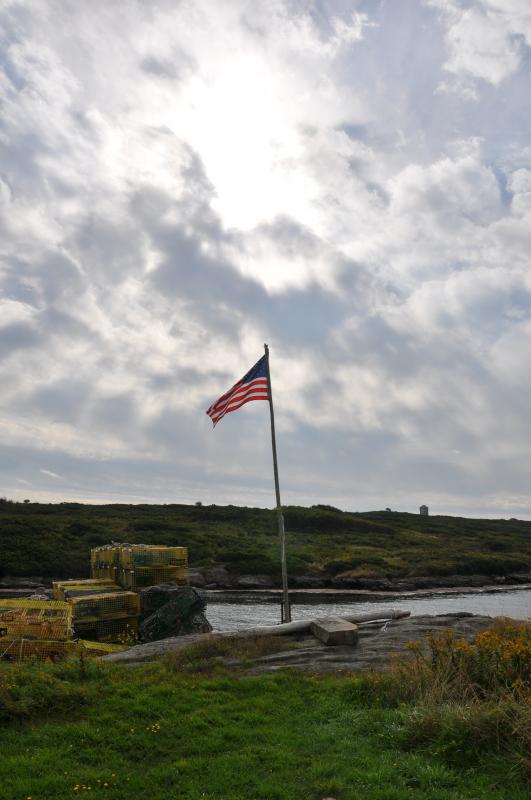 A flag whips in the early morning wind. Kathy Ferguson talks Emma Goldman, anarchism, and current iterations of anarchism in mainstream culture September 20 at the Skidompha Library in Damariscotta. Ferguson recently wrote "Emma Goldman: Political Thinking in the Streets,” and was part of the library's Chats with Champions lecture series. BEN BULKELEY/Boothbay Register
A flag whips in the early morning wind. Kathy Ferguson talks Emma Goldman, anarchism, and current iterations of anarchism in mainstream culture September 20 at the Skidompha Library in Damariscotta. Ferguson recently wrote "Emma Goldman: Political Thinking in the Streets,” and was part of the library's Chats with Champions lecture series. BEN BULKELEY/Boothbay Register 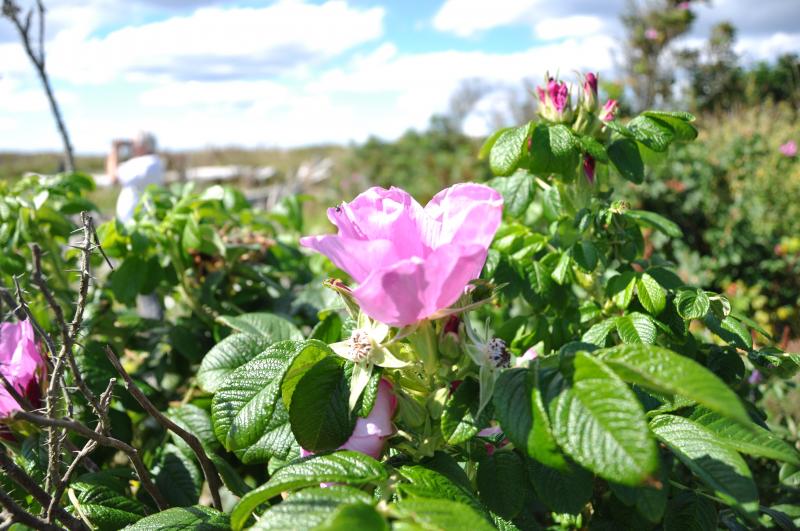 A Rosa rugosa, which came to Damariscove from Asia, is on full display. BEN BULKELEY/Boothbay Register
A Rosa rugosa, which came to Damariscove from Asia, is on full display. BEN BULKELEY/Boothbay Register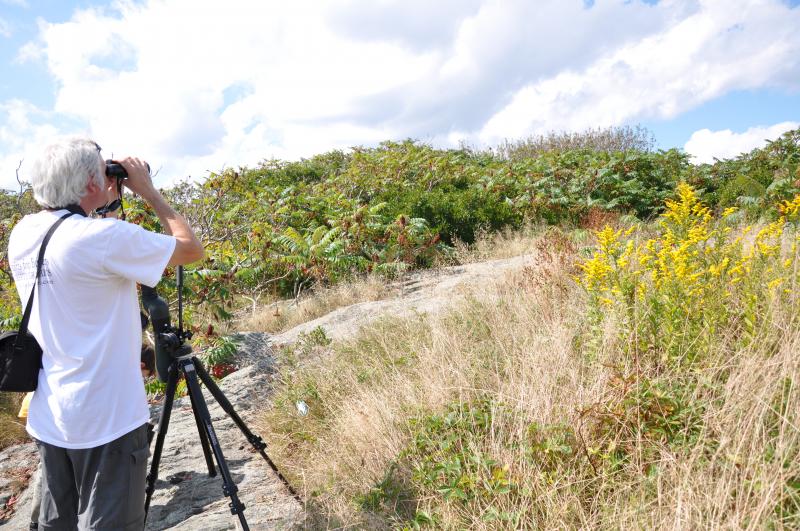 Ornithologist Jeff Wells looks through a telescope at stirring cat birds. BEN BULKELEY/Boothbay Register
Ornithologist Jeff Wells looks through a telescope at stirring cat birds. BEN BULKELEY/Boothbay Register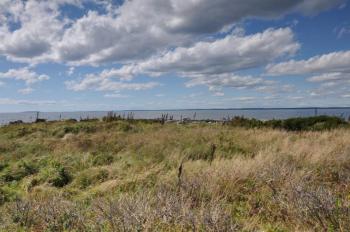 Damariscove, which is located five miles east from Boothbay Harbor, has been among other things, a place for Abenaki tribes to gather food, a place for drying fish, a Coast Guard station, a safe harbor and now a preserve for wildlife. BEN BULKELEY/Boothbay Register
Damariscove, which is located five miles east from Boothbay Harbor, has been among other things, a place for Abenaki tribes to gather food, a place for drying fish, a Coast Guard station, a safe harbor and now a preserve for wildlife. BEN BULKELEY/Boothbay Register A rusted piece of metal is all that remains of a ship near where the drying racks were once located. BEN BULKELEY/Boothbay Register
A rusted piece of metal is all that remains of a ship near where the drying racks were once located. BEN BULKELEY/Boothbay Register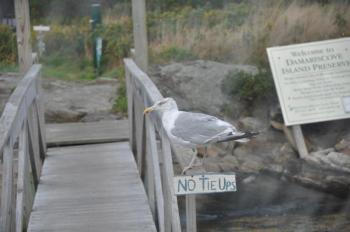 A seagull watches as Balmy Days Cruises' Novelty came in to dock at Damariscove. BEN BULKELEY/Boothbay Register
A seagull watches as Balmy Days Cruises' Novelty came in to dock at Damariscove. BEN BULKELEY/Boothbay Register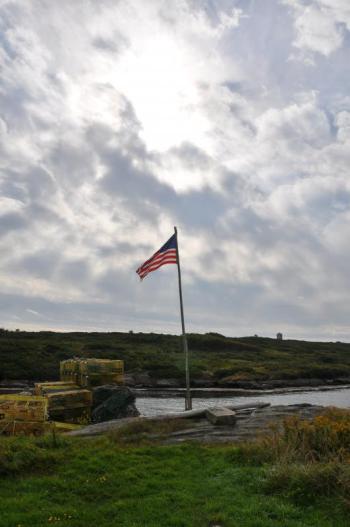 A flag whips in the early morning wind. Kathy Ferguson talks Emma Goldman, anarchism, and current iterations of anarchism in mainstream culture September 20 at the Skidompha Library in Damariscotta. Ferguson recently wrote "Emma Goldman: Political Thinking in the Streets,” and was part of the library's Chats with Champions lecture series. BEN BULKELEY/Boothbay Register
A flag whips in the early morning wind. Kathy Ferguson talks Emma Goldman, anarchism, and current iterations of anarchism in mainstream culture September 20 at the Skidompha Library in Damariscotta. Ferguson recently wrote "Emma Goldman: Political Thinking in the Streets,” and was part of the library's Chats with Champions lecture series. BEN BULKELEY/Boothbay Register 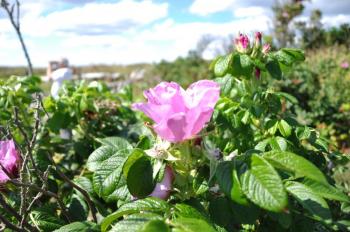 A Rosa rugosa, which came to Damariscove from Asia, is on full display. BEN BULKELEY/Boothbay Register
A Rosa rugosa, which came to Damariscove from Asia, is on full display. BEN BULKELEY/Boothbay Register Ornithologist Jeff Wells looks through a telescope at stirring cat birds. BEN BULKELEY/Boothbay Register
Ornithologist Jeff Wells looks through a telescope at stirring cat birds. BEN BULKELEY/Boothbay RegisterFor a place considered one of the first settlements of the New World, there isn’t much fanfare for Damariscove Island.
There is some literature, a museum and lichen-covered foundations of early buildings, but the two-mile-long island, roughly five miles from Boothbay Harbor, remains much as it always has: an island apart.
Even in the literature provided by the Boothbay Region Land Trust, Damariscove is compared to the Scottish Highlands before another famous Maine island, Monhegan, is even mentioned.
Damariscove doesn’t look like the islands around it. It’s low-slung, rolling and bare, save for a scraggly rash of trees near the caretaker’s cabin, and doesn’t evoke the tufted, evergreen sprouts of Squirrel or Outer Heron islands.
Since the Coast Guard station that had been in operation for 70 years closed in 1967, the island has been primarily a refuge for nesting birds and the assorted and eclectic plants that washed ashore.
It’s close enough to shore to be seen as useful for those on the mainland, but far enough away that it has since been almost abandoned, save for being an active port for local lobstermen.
Damariscove seems like a ghost town atop a desolate piece of Northern Atlantic rock. In reality, the island is as alive as it ever was. It has several small ecosystems wherein life somehow continues to thrive.
And, true to its history, it’s again changing.
Nature’s appetite
On September 15, the Boothbay Region Land Trust took more than 30 people to the island by way of the Balmy Days Cruises' Novelty to view the island’s flora and fauna.
The tour began with leaden-gray skies and substantial swells that made the Novelty pitch and bob along with the eider ducks that circle the island looking for nourishment in the shallows near the rocks around the mouth of the harbor. But, as the Novelty steamed back to Boothbay, a pillar of light opened up over the Atlantic, and Damariscove was awash in early morning light.
As guests departed the Novelty they were introduced to a place that seems to be lost in time, said Tracy Hall, former caretaker of the island and Boothbay Region Land Trust.
Along with BRLT’s Nick Ullo, Hall got to know the island intimately when she was a summer caretaker there from 2002 to 2008.
“Having spent seven summers out there it holds a very special meaning to me,” she said. “To me, it’s a place that captures how still and quiet the world can be.
“It’s almost like stepping back in time.”
Damariscove is a hardy little island. Its rock foundation was too tough to be scrubbed away by glaciers during the last ice age. It withstood whatever came from the ocean and has been a feature of Maine’s Midcoast for as long as there have been Mainers.
Like the mainland it flanks, Damariscove has evolved and changed. Throughout its history it has almost been an appendix to the flurry of activity on the coast. Its industries and labors mirrored those of the world around it, but only on a smaller, sometimes more difficult scale.
Damariscove was used by local Abenaki tribes as a place to gather eggs from nesting birds until the island, and the mainland, changed forever in 1604 with the arrival of Europeans.
The Europeans, like most of Damariscove’s seasonal and permanent residents, washed ashore and tried to make the most of the fickle island. For the new inhabitants, it became a safe harbor from roiling seas and a place to dry fish before sending their hauls back across the Atlantic.
The island looked different when it was one of the first settlements of the New World, Hall said.
“We assume (the eastern portion of the island) was forested when the fishermen got here in the 1600s,” she said. “Then, they probably cleared it to make the racks to dry fish before they were sent off to England.”
“It’s a place that captures how still and quiet the world can be.” Tracey Hall, former Damariscove caretaker
But the fishermen weren’t alone for long. In the 18th century, the island was cleared of its trees not just for timber, but to make room for its newest inhabitants: sheep, cows and the farmers who tended to them.
All that time the island was still a place for fishermen to dry their catch, but it also supported a dairy industry. Damariscove’s dairy farmers milked in the morning, then set off for Squirrel Island, where they rowed for half the day just to reach its shores. After selling the milk to Squirrel's residents, the other half of the day was spent rowing back to Damariscove.
Ullo said that at one point in the 19th century, there were more than 200 inhabitants on Damariscove. It was also granted Maine’s first liquor license, to sate the thirst of the fishermen and farmers who blew out onto the island, Ullo said.
That population has since atrophied. Now the muskrat is the only year-round mammal occupant on the island. The only buildings left are the caretaker’s inn, an outhouse, the former Coast Guard station, the museum and an outpost.
There are foundations made from rock carved from quarries located on the island that still stand, only with wild grass and creeping lichen where barns and houses used to sit.
The drying rack foundations, cut from the very rock that comprise the island, still stand, but now serve as a reminder of what the island once was, Hall said.
“Now, it’s a nature preserve, so you don’t get that sense of history until you start walking around,” she said. “You see the old foundations and some of the info in the museum. It’s so quiet now that it’s hard to believe it was once a bustling fishing community.
“There are places where nature has taken its course – it’s swallowing up the history.”
The lonely journey of the semipalmated plover
Whether accidentally or on purpose, Damariscove's inhabitants have come from somewhere else and often leave something behind. Its history reads as a tale of being shaped by its visitors.
For all its splendor and abundance, one of the island’s most prominent plants, the rosa rugosa, is an invader from Asia.
Some of the island’s inhabitants are just following the instinct to keep moving; to keep pushing forward.
A lot of the birds on the island that wouldn’t normally be found there, often are looking for a safe harbor of their own, ornithologist Jeff Wells said.
“Sometimes, they just find themselves out over the ocean, and obviously, that isn’t where they want to be,” he said.
Much like the first human visitors to Damariscove, the birds that occupy the island usually came from away.
Most, like the great horned owls who call the island home year-round and the cat-bird, simply flew from the mainland to the small island where they could carve out a niche alone.
But some birds, like the semipalmated plover, come from far away.
Plovers are hatched in the arctic during the summer, then unceremoniously shoved into adulthood shortly thereafter. Damariscove was only stop for one such plover spotted on the tour. The small brown and white bird would need to migrate to Caribbean from the island.
"There is just something that clicks in their head," Wells said to the tour in the crux of Damariscove’s harbor as the bird darted on the rocks nearby. "They just somehow know where to go — they know when to head south."
The plover appeared to be on its own until the end of Wells’ tour when another chirruped overhead and flew over the island.
Any greens necessary
On the Eastern side of the island, where pewter-colored waves crashed against fractured stone, it seemed that there would be no life. But a large float of Eider ducks bobbed like downy buoys as Coastal Maine Botanical Gardens botanist Melissa Cullina instructed her tour to search for an unexpected resident of the island.
After a few moments, someone called back to Cullina that they had found what she was after. They had found a small rust-colored flower the size of a button, and lost it just as easily on the sea-sprayed rocks.
“(Damariscove) and Monhegan are the only two places I’ve seen the scarlet pimpernel grow so close to the coast,” Cullina said.
The rare flower is just one example of species surviving in a place where life doesn’t appear obvious at first glance. Along Cullina’s tour, she described and pointed out the unabashedly-violet New York Astor and the less obvious red bartsia.
Cullina also made a point to stop in front of blackberry and raspberry bushes and the less obvious and just-as-important goose tongue, or seaside plantain. All those plants, Cullina said, had one thing in common – they allowed the residents of the island to live when times became tough.
"In 1606, I imagine they ate whatever they had available," she said. "Anything they could find that was useful to them, they used."
The rosa rugosa bushes were used as tea; the stag horn sumac was repurposed into a lemonade-like drink and the goose tongue was pickled or eaten raw in the spring. Food, despite not being entirely obvious at first glance, was everywhere, Cullina said.
The next phase of Damariscove
When Ullo and Hall first arrived on the island in 2002, it was different than it looks a decade later.
“When we came here in 2002, it truly was a treeless island,” he said. “I don’t think we can say that anymore. There are trees popping up.”
The next phase of succession, when grasslands give way to trees and more substantial flora, takes time, Ullo said.
But, true to its history, Damariscove is again changing. That’s why it is important to visit the island, Ullo said.
“An island like Damariscove has such a significant value – it has a significant habitat and historical value,” he said. “It really needs to be shared with as many people as possible. That’s why I think it’s important we do these trips out to the island.”
Event Date
Address
United States




























